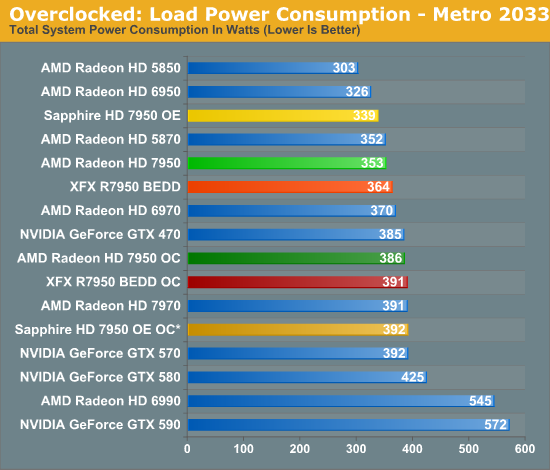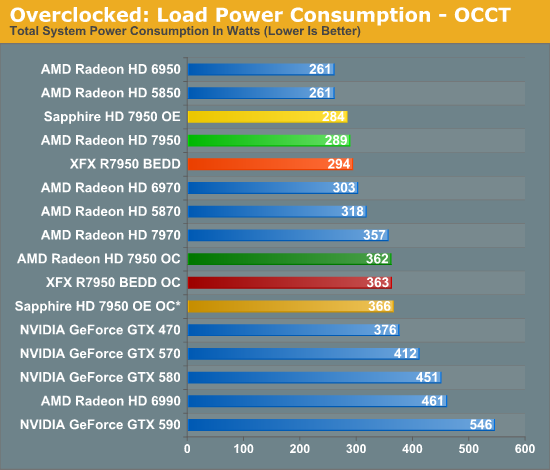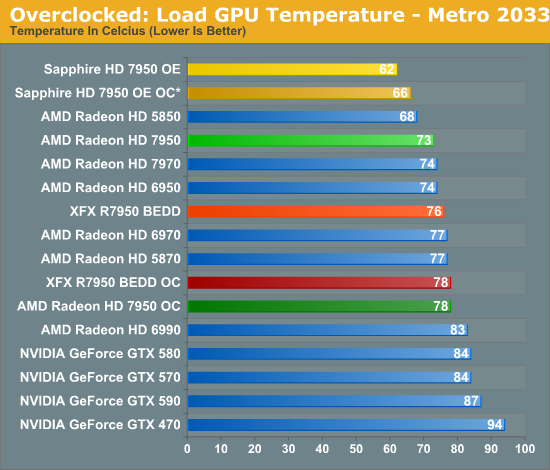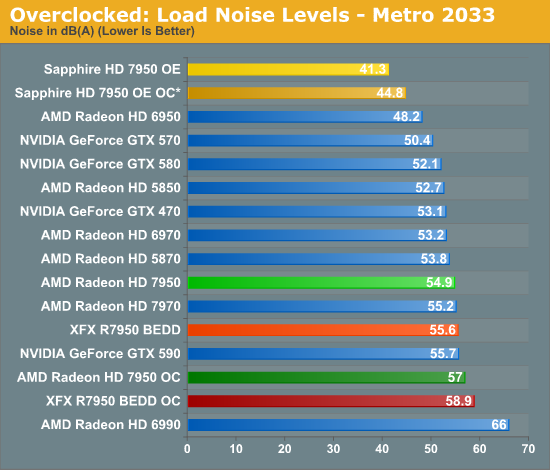AMD Radeon HD 7950 Review Feat. Sapphire & XFX: Sewing Up The High-End Market
by Ryan Smith on January 31, 2012 9:02 AM ESTOverclocking: Power, Temp, & Noise
In their marketing materials AMD is heavily pushing overclocking, and they have good reason to. With the 7970 we’ve established that Tahiti has quite a bit of overclocking headroom, and as the 7950 is clocked lower by default this opens up that headroom even further. Realistically AMD’s binning process means that the best clocking Tahiti GPUs are going to be allocated to the 7970 unless they have failed shaders, but even with that there’s quite a bit of potential on paper.
As with overclocking the 7970, our goal overclocking the 7950 is to see how much you can get for free; that is without any voltage adjustments. AMD’s reference PCBs are not particularly overbuilt for overclocking—cards like that will come later—so sticking to the reference voltage is the safest option, not to mention the easiest. With the 7970 we were able to get 200MHz (22%) overclocks without any voltage adjustment, and we’re hoping for the same out of the 7950.
With that said, we quickly ran into a wall on one card: the Sapphire 7950. Sapphire’s low VID of 0.993v may be great for temperature and noise at stock, but it’s not doing overclocking any favors. We only hit 950MHz at that voltage. As the Sapphire was the odd man out—every other card was at 1.093v—we did end up overvolting the Sapphire to 1.093v to see what it was capable of when put on similar footing as the rest of our cards.
After bringing up the voltage of our Sapphire card, all of our 7950s ended up overclocking to very similar levels. Our Sapphire and AMD cards topped out at 1025MHz core, a 225MHz (28%) overclock over a stock 7950 and a 125MHz (14%) overclock over the Sapphire’s factory overclock, while our XFX card reached 1050MHz, a 150MHz (17%) overclock beyond XFX’s factory overclock. Meanwhile the memory clocks on all of our cards topped out at 5.8GHz, beyond which we’d start seeing performance regressions from error correction on the memory bus.
| Radeon HD 7950 Overclocking | |||||
| AMD Radeon HD 7950 | Sapphire HD 7950 Overclock Edition | XFX R7950 BEDD | |||
| Shipping Core Clock | 800MHz | 900MHz | 900MHz | ||
| Shipping Memory Clock | 5GHz | 5GHz | 5.5GHz | ||
| Shipping Voltage | 1.093v | 0.993v | 1.093v | ||
| Overclock Core Clock | 1025MHz | 1025MHz | 1050MHz | ||
| Overclock Memory Clock | 5.8GHz | 5.8GHz | 5.8GHz | ||
| Overclock Voltage | 1.093v | 1.093v | 1.093v | ||
As you can imagine, with such similar overclocks, gaming performance on all 4 cards ended up being very similar. So we’ll get to gaming performance in a minute, while we’ll start with power, temperature, & noise.


Even though we’re not increasing the voltage on our AMD and XFX cards, merely overclocking them and raising the PowerTune limit to avoid throttling does drive the power consumption up. As is typical with heavily overclocked cards, overclocking quickly drives up power consumption and the 7950s are no exception. After overclocking power consumption is almost identical to the stock 7970, so while you can get 7970 performance you still need to pay the price with 7970 power consumption. Meanwhile it’s interesting to note that even with the extra 0.1v we’ve given the Sapphire card its final power consumption is only ever so slightly higher than the other 7950s, proving that voltage is the great equalizer in this case.


With the increase in power comes an increase in temperatures. The Sapphire card still does very well here staying in the low 70s even under OCCT, while the reference and XFX cards hit the high 70s under Metro and mid 80s under OCCT. As we’ve yet to really ascertain what the thermal limits are for Tahiti, it’s not clear whether there’s too much thermal headroom left for the GPU, particularly under OCCT.


Last but not least we have load noise. The Sapphire card is once more a stellar performer, and we still can’t get it above 50dB even with OCCT. Unfortunately the XFX 7950 BEDD has its biggest fallout yet—it may be able to overclock well, but at 64dB under OCCT the performance isn’t going to be worth the immense amount of noise it creates to move enough air to keep the GPU cool.










259 Comments
View All Comments
chizow - Saturday, February 4, 2012 - link
I have explained this. Because the market expects there to be a shift in the price:performance metrics when a new generation or new architecture of GPUs launches. This is the driving factor of progress, more performance at the same prices.Tahiti offers none of this, so once again, AMD is either ignoring the fact Nvidia 28nm parts are imminent and may very well invalidate their entire product line a few months after launch. Or they think Nvidia's 28nm parts aren't any faster than their 40nm parts. Or they think their customers are stupid.
In all 3 cases, I can't see this ending well for them. Unless Nvidia prices their new parts to the moon like $750+, and then no one wins (or has any reason to upgrade for that matter). The only people who would have any incentive to upgrade will be the ones who need to have the absolute fastest, then they'll have to decide if $750/1500/2250/3000 is worth it for a minor bump in performance over what they had with $500 flagship parts.
chizow - Saturday, February 4, 2012 - link
Well, you'd be stupid not to verify and fact check what I've stated by referencing the financials before opening your mouth. Its all right there, links and everything.Given your other comments on the topic however, ignorantly commenting seems par for the course with you.
chizow - Saturday, February 4, 2012 - link
I'm well aware of that. I'm also well aware that top-end performance from 3 years ago doesn't command $1000 prices anymore, it fetches $300 max. That's what we call progress.Its also why AMD can only charge $200 for their top-end CPU, because what they have today still doesn't compete with what Intel has at $300 today and what they asked $1000 for 3-years ago.
But its OK, you've made it abundantly clear you see nothing wrong with charging the same price for the same performance as last-gen parts some 14 months later.
chizow - Saturday, February 4, 2012 - link
Is it nice for you? Because you're clearly out of your league in this discussion.chizow - Saturday, February 4, 2012 - link
CYA!Galidou - Sunday, February 5, 2012 - link
Oh yeah, if the pricing is so stupid, why is it out of stock everywhere after a week?Oh right, supply and demand is a market thing but the only thing you understand is history of pricing and ATI being a company that doesn't know what they do, maybe you should become marketting master, seems like you'Re right about everything in the damn world...
Galidou - Sunday, February 5, 2012 - link
They freaking knew what they were doing FFS.And from the beginning I knew nothing was SO wrong with it because if it was the case, they wouldn't of sold EVERYTHING in a damn week...
Prices will go down soon, they just knew the initial stock would sell like hotcakes and when it starts to slow down, price it accordingly.
Supply and demand...
chizow - Saturday, February 4, 2012 - link
And apparently this is the same mistake AMD has made by shoving in their head in the sand trying to ignore that ominous cloud called Kepler.Its fine, buy these cards today, regret the decision tomorrow, a month from now, two months from now.
I know the AMD fanboys probably hate me today for pointing this out and shoving it in their faces, but I can guarantee you anyone who buys one of these cards today won't be mad at me when Kepler cuts their price at the knees, they'll be pissed off at AMD.
chizow - Saturday, February 4, 2012 - link
This is the online equivalent of holding your hands over year ears and shouting "lalala I can't hear you lalala".Your arguments were pretty weak to begin with but now they've just devolved into childish nonsense.
chizow - Saturday, February 4, 2012 - link
Um, no you're wrong.How is it a bad thing when Apple can't meet demand on iPhone? Or Nintendo can't meet demand on Wii? Or Amazon can't meet demand on Kindle? Or Nvidia can't meet demand on Fermi? Or AMD can't meet demand on Cypress?
Demand oustripping supply is any economist or business owner's dream situation lol, if you don't under this YOU have no understanding of very basic economic principles.